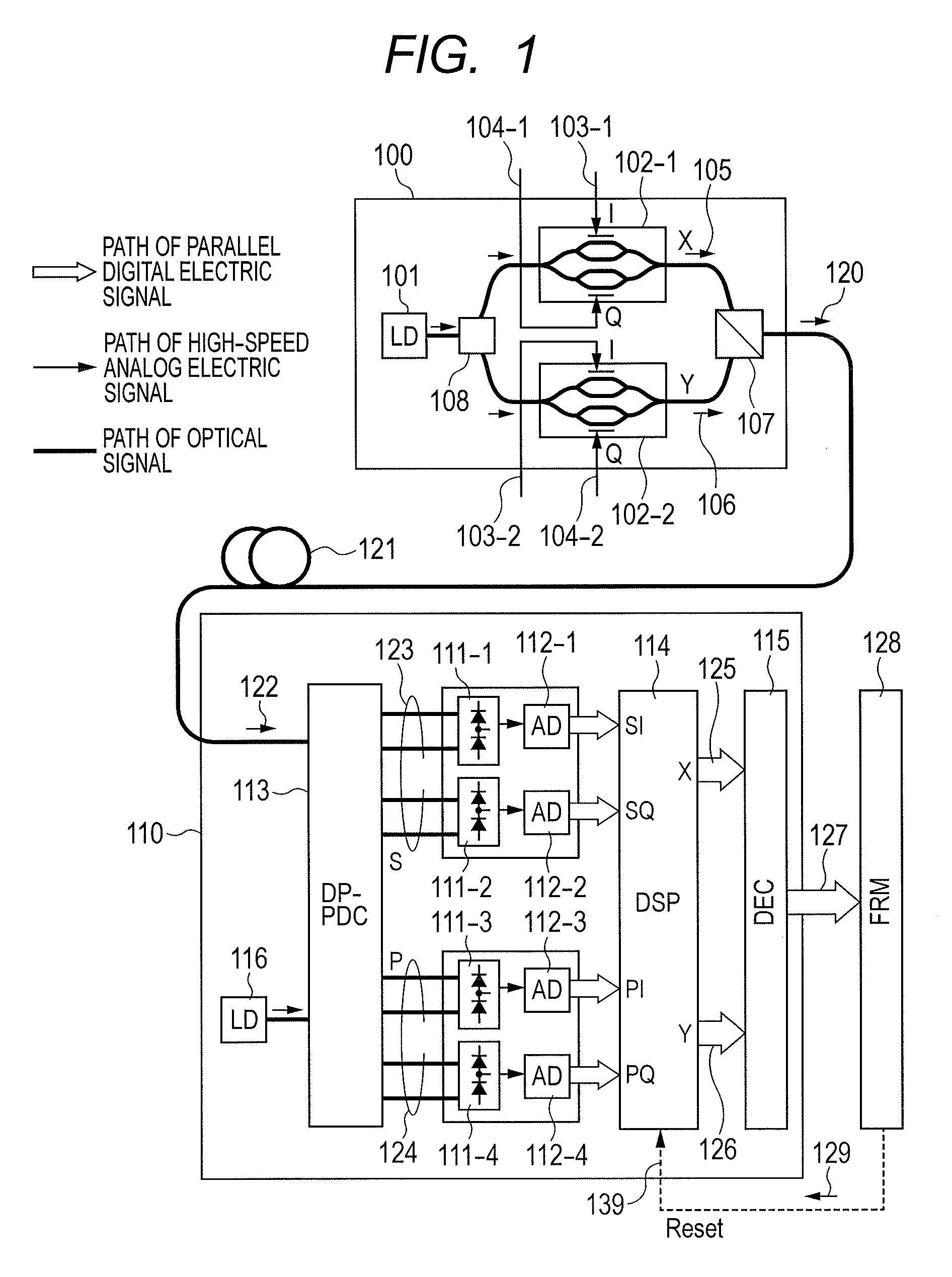Polarization-Multiplexed Optical Transmission System, Polarization-Multiplexed Optical Transmitter, and Polarization-Multiplexed Optical Receiver
a polarization-multiplexed optical and transmission system technology, applied in the direction of polarization multiplex systems, multi-channel communication, electromagnetic transmission, etc., can solve the problem of unable to determine which of the x-polarization component and the y-polarization component from the transmission side is extracted to the two ports, and unable to completely prevent the singularity problem. to achieve the effect of preventing signal quality degradation and high-reliability
- Summary
- Abstract
- Description
- Claims
- Application Information
AI Technical Summary
Benefits of technology
Problems solved by technology
Method used
Image
Examples
first embodiment
[0075]FIG. 5 is a configuration diagram showing a digital coherent polarization-multiplexed transmission system according to the invention. As shown in FIG. 5, a polarization-multiplexed optical transmitter 200 according to the embodiment outputs a polarization-multiplexed optical transmission signal 212 according to the embodiment. The optical transmission signal 212 is transmitted through an optical fiber transmission path 121. A polarization diversity coherent optical receiver 215 according to the embodiment receives the optical transmission signal 212 as a polarization-multiplexed received optical signal 213 according to the embodiment. In the following drawings, an outline arrow represents the path of a digital signal. A thin line represents the path of a high-speed analog electric signal. A thick line represents the path of an optical signal. A broken line represents the path of a low-speed control signal. Throughout the drawings, the same parts or components as those of the r...
second embodiment
[0097]FIG. 9 is a configuration diagram showing a polarization-multiplexed optical transmitter according to the invention. The example shows another method of generating a frequency shift signal. As described with reference to FIGS. 6C and 6D, the embodiment may modulate X-polarization and Y-polarization components using the signal points that slowly rotate at mutually different rates. The example in FIG. 9 directly generates an X-polarization modulation signal using a rotational multilevel encoding table 232 without using multiplication.
[0098]In a multilevel encoding circuit 230 according to the embodiment, an encoding logic circuit 231 outputs an intermediate sign 235-1 for the X-polarization component corresponding to an input information signal. The intermediate sign is used for the description and need not be used for the implementation. The following description assumes 4-value modulation using four values where d is set to 0 through 3. A clock circuit 233 outputs an index num...
fourth embodiment
[0103]FIG. 13 is an explanatory diagram showing a polarization-multiplexed optical transmitter 200 according to the invention. The example uses analog operations to generate the above-mentioned rotating multilevel signal points without using a digital operation or a high-speed DA converter. The configuration directly replaces the components in FIG. 5 with analog operations. A complex analog multiplier 252 complex-multiplies a complex analog multilevel signal 251 input to the transmitter by a sine wave for the frequency Δf supplied from a frequency-agile sine wave oscillator (low-frequency analog oscillator) 250. As a result, the frequency shift is generated. Specifically, the frequency-agile sine wave oscillator 250 outputs a signal that is used as a cosine wave cos (2πΔft). A 90-degree phase shifter 254 converts the output signal into a sine wave sin (2πΔft). The cosine wave and the sine wave respectively correspond to the real part and the imaginal part of a complex sine wave sign...
PUM
 Login to View More
Login to View More Abstract
Description
Claims
Application Information
 Login to View More
Login to View More - R&D
- Intellectual Property
- Life Sciences
- Materials
- Tech Scout
- Unparalleled Data Quality
- Higher Quality Content
- 60% Fewer Hallucinations
Browse by: Latest US Patents, China's latest patents, Technical Efficacy Thesaurus, Application Domain, Technology Topic, Popular Technical Reports.
© 2025 PatSnap. All rights reserved.Legal|Privacy policy|Modern Slavery Act Transparency Statement|Sitemap|About US| Contact US: help@patsnap.com



